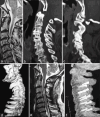Defining role of atlantoaxial and subaxial spinal instability in the pathogenesis of cervical spinal degeneration: Experience with "only-fixation" without any decompression as treatment in 374 cases over 10 years
- PMID: 38644907
- PMCID: PMC11029116
- DOI: 10.4103/jcvjs.jcvjs_11_24
Defining role of atlantoaxial and subaxial spinal instability in the pathogenesis of cervical spinal degeneration: Experience with "only-fixation" without any decompression as treatment in 374 cases over 10 years
Abstract
Aim: The authors analyze their published work and update their experience with 374 cases of cervical radiculopathy and/or myelopathy related to spinal degeneration that includes ossification of the posterior longitudinal ligament (OPLL). The role of atlantoaxial and subaxial spinal instability as the nodal point of pathogenesis and focused target of surgical treatment is analyzed.
Materials and methods: During the period from June 2012 to November 2022, 374 patients presented with acute or chronic symptoms related to radiculopathy and/or myelopathy that were attributed to degenerative cervical spondylotic changes or due to OPLL. There were 339 males and 35 females, and their ages ranged from 39 to 77 years (average 62 years). All patients were treated for subaxial spinal stabilization by Camille's transarticular technique with the aim of arthrodesis of the treated segments. Atlantoaxial stabilization was done in 128 cases by adopting direct atlantoaxial fixation in 55 cases or a modified technique of indirect atlantoaxial fixation in 73 patients. Decompression by laminectomy, laminoplasty, corpectomy, discoidectomy, osteophyte resection, or manipulation of OPLL was not done in any case. Standard monitoring parameters, video recordings, and patient self-assessment scores formed the basis of clinical evaluation.
Results: During the follow-up period that ranged from 3 to 125 months (average: 59 months), all patients had clinical improvement. Of 130 patients who had clinical evidences of severe myelopathy and were either wheelchair or bed bound, 116 patients walked aided (23 patients), or unaided (93 patients) at the last follow-up. One patient in the series was operated on 24 months after the first surgery by anterior cervical route for "adjacent segment" disc herniation. No other patient in the entire series needed any kind of repeat or additional surgery for persistent, recurrent, increased, or additional related symptoms. None of the screws at any level backed out or broke. There were no implant-related infections. Spontaneous regression of the size of osteophytes was observed in 259 patients where a postoperative imaging was possible after at least 12 months of surgery.
Conclusions: Our successful experience with only spinal fixation without any kind of "decompression" identifies the defining role of "instability" in the pathogenesis of spinal degeneration and its related symptoms. OPLL appears to be a secondary manifestation of chronic or longstanding spinal instability.
Keywords: Intervertebral disc; myelopathy; ossification of posterior longitudinal ligament; spondylosis.
Copyright: © 2024 Journal of Craniovertebral Junction and Spine.
Conflict of interest statement
There are no conflicts of interest.
Figures



Similar articles
-
Role of Subaxial Spinal and Atlantoaxial Instability in Multisegmental Cervical Spondylotic Myelopathy.Acta Neurochir Suppl. 2019;125:71-78. doi: 10.1007/978-3-319-62515-7_11. Acta Neurochir Suppl. 2019. PMID: 30610305
-
Ossification of the Posterior Longitudinal Ligament: Analysis of the Role of Craniovertebral and Spinal Instability.Acta Neurochir Suppl. 2019;125:63-70. doi: 10.1007/978-3-319-62515-7_10. Acta Neurochir Suppl. 2019. PMID: 30610304
-
"Only Spinal Fixation" as Surgical Treatment of Cervical Myelopathy Related to Ossified Posterior Longitudinal Ligament: Review of 52 Cases.World Neurosurg. 2020 Aug;140:556-563. doi: 10.1016/j.wneu.2020.03.198. World Neurosurg. 2020. PMID: 32797987
-
Pediatric cervical kyphosis in the MRI era (1984-2008) with long-term follow up: literature review.Childs Nerv Syst. 2022 Feb;38(2):361-377. doi: 10.1007/s00381-021-05409-z. Epub 2021 Nov 22. Childs Nerv Syst. 2022. PMID: 34806157 Review.
-
A modified decompression surgery for thoracic myelopathy caused by ossification of posterior longitudinal ligament: a case report and literature review.Spine (Phila Pa 1976). 2010 Jun 1;35(13):E609-13. doi: 10.1097/BRS.0b013e3181cef65a. Spine (Phila Pa 1976). 2010. PMID: 20461031 Review.
Cited by
-
Risk Factor Analysis and Risk Prediction Model Construction of Ossification Progression After Postoperative Cervical Ossification of Posterior Longitudinal Ligament.Spine (Phila Pa 1976). 2025 Aug 1;50(15):1025-1034. doi: 10.1097/BRS.0000000000005286. Epub 2025 May 22. Spine (Phila Pa 1976). 2025. PMID: 40401820 Free PMC article.
-
Chronic muscle pain and spasm hallmarks of spinal instability.J Craniovertebr Junction Spine. 2024 Jul-Sep;15(3):263-265. doi: 10.4103/jcvjs.jcvjs_137_24. Epub 2024 Sep 12. J Craniovertebr Junction Spine. 2024. PMID: 39483831 Free PMC article. No abstract available.
References
-
- Lebl DR, Bono CM. Update on the diagnosis and management of cervical spondylotic myelopathy. J Am Acad Orthop Surg. 2015;23:648–60. - PubMed
-
- Shedid D, Benzel EC. Cervical spondylosis anatomy: Pathophysiology and biomechanics. Neurosurgery. 2007;60:S7–13. - PubMed
-
- Furlan JC, Kalsi-Ryan S, Kailaya-Vasan A, Massicotte EM, Fehlings MG. Functional and clinical outcomes following surgical treatment in patients with cervical spondylotic myelopathy: A prospective study of 81 cases. J Neurosurg Spine. 2011;14:348–55. - PubMed
-
- Fehlings MG, Tetreault LA, Wilson JR, Skelly AC. Cervical spondylotic myelopathy: Current state of the art and future directions. Spine (Phila Pa 1976) 2013;38:S1–8. - PubMed
LinkOut - more resources
Full Text Sources
